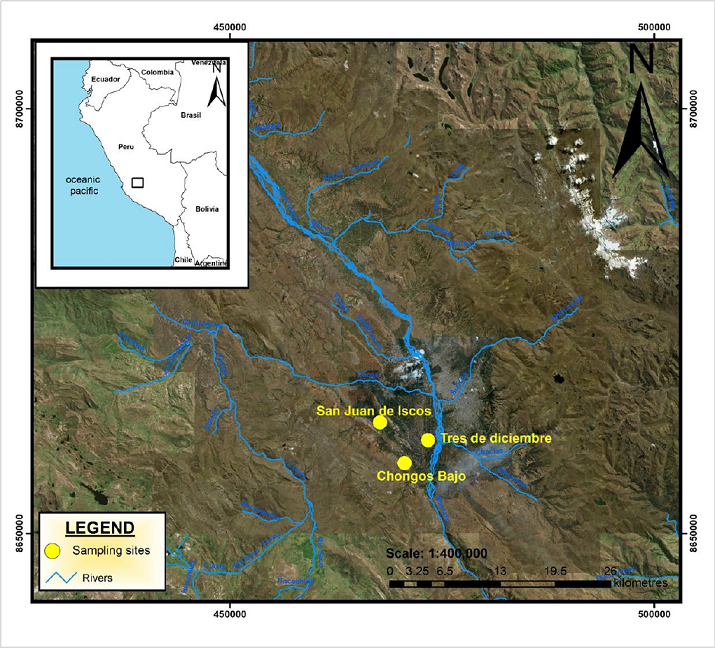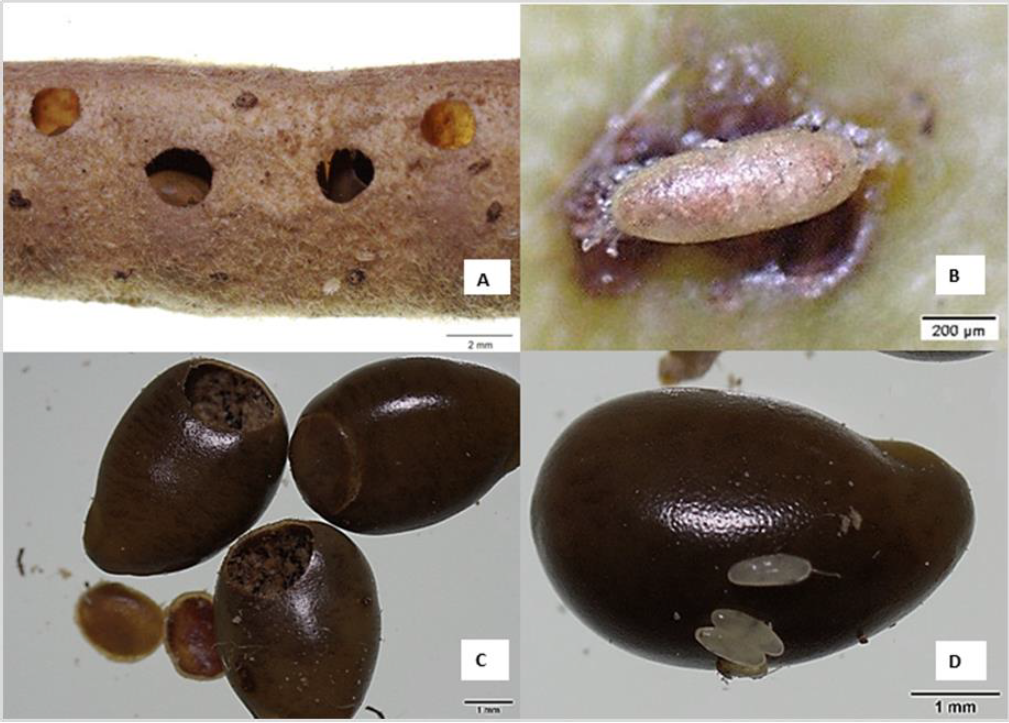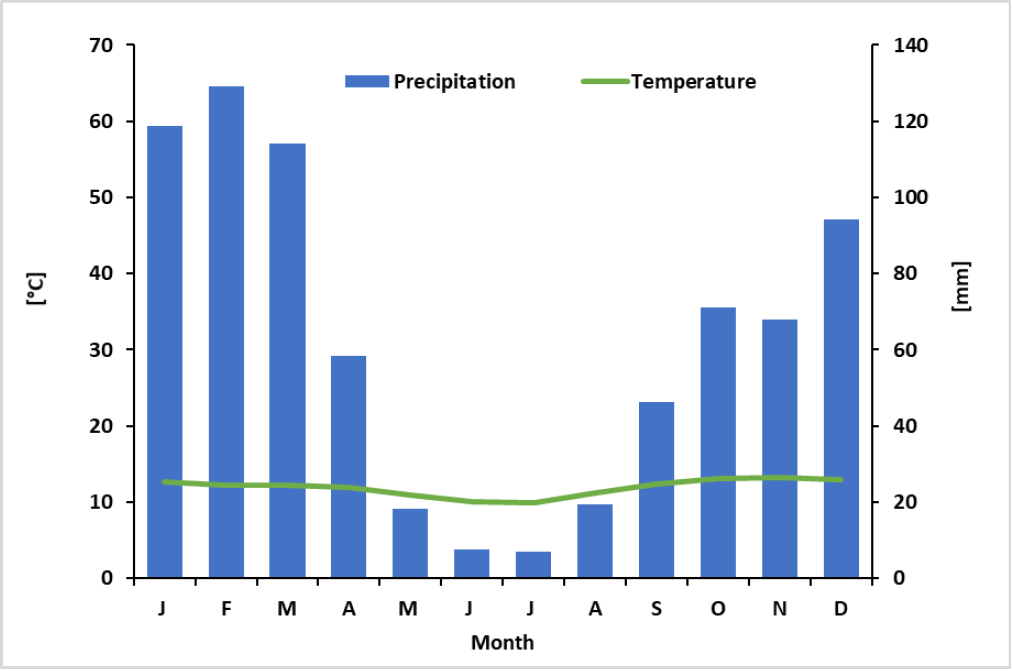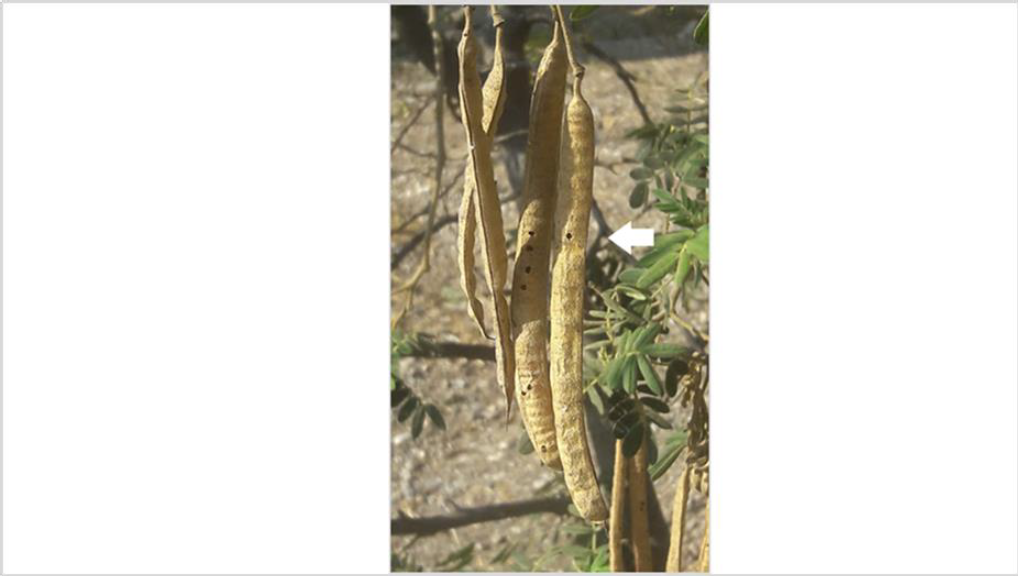Introduction
There are about 2,800,000 ha of natural tropical forests in the Peruvian Andes, among which the shrub Senna multiglandulosa. (Jacq.) (Fabaceae) stands out. It is highly appreciated for its medicinal properties and as an ornamental plant (Castañeda et al., 2017; Franco et al.; 2016; Singh et al., 2013). Senna multiglandulosa is distinguished by its hairy-pubescent foliage and yellow flowers; its legume is pendular, gently curved, with a 4-7 mm stipe, and a hairy body with late dehiscence, whose seed is somewhat compressed and ovoid, with a smooth, glossy chestnut-brown testa (Irwin & Barnevy, 1982).
Acanthoscelides obtectus (Say, 1831) is a beetle of the order Coleoptera, family Chrysomelidae, and subfamily Bruchinae of neotropical origin (Johnson & Romero, 2004; Thakur, 2012). It is worldwide recognized as one of the most critical seed pests of Phaseolus vulgaris L. and other Fabaceae species (Gad, 2019; Guzmán et al., 1996; Kaplan et al., 2018; Thakur, 2010; Vera-Graziano et al., 2011). It is a serious threat to legumes like P. vulgaris (Thakur, 2012), Acacia tortuosa (L.) Willd., Prosopis juliflora (Sw.) DC. (D’Aubeterre et al., 2012) and Vigna unguiculata (L.) Walp. (Ramírez et al., 2017). Its immature stages feed on the seeds of around 34 plant families, mainly legumes (Ramírez & Suris, 2015). Bruchinae have a cosmopolitan distribution, but the largest number of species inhabit the tropical regions of Asia, Africa, and Central and South America (Ramírez et al., 2017). Acanthoscelides obtectus (Say) is a cosmopolitan pest of tropical and subtropical regions (Njoroge et al., 2017; Savković et al., 2019) but prefers cold climates and altitudes. Therefore, it can be found in mountainous and subtropical regions of Latin America (Cardona, 1989).
The larvae feed mainly on the embryo and endosperm of the seeds, causing damage and economic losses in the field and under storage (Baier & Webster, 1992; Fernández-Andrés et al., 2009). In the field, the adults lay their eggs inside the legume pods (= plants of the Fabaceae family), emerging as larvae and penetrating the seeds to emerge as adults; the cycle repeats four times a year (Dell’Orto & Arias, 1985; Godinez-Cortes, 2013). The exit holes are typically circular with a fine contour, unlike those of other insects that are usually irregular and rough cut (Kingsolver & Decelle, 1979). Adults feed on pollen where immature forms develop (Romero et al., 2009).
Anthropogenic dissemination and favorable temperature and humidity conditions have led to a geographical expansion of A. obtectus beetles from temperate to subtropical climates. (Godinez-Cortes, 2013). The Mantaro Valley (MV) is located in the central Andes of Peru, an area with a diversity of medicinal plants. In recent years, these have been reducing their availability due to the deterioration of natural environments (Tello-Ceron, Flores & Gomez, 2019), plagues, and diseases. The bush S. multiglandulosa is a species adapted in the MV (Yarupaitán & Albán, 2004), and local people highly appreciate it for its medicinal, fuel, and ornamental use. A systematic review of scientific reports on the existence of this beetle in wild plants does not reveal the presence of A. obtectus in bushes of S. multiglandulosa, despite inspections and local testimonies (Servicio Nacional de Sanidad Agraria [SENASA], 2018).
Given the urgency of devoting attention to the study of this pest in Andean areas of South America (Alvarez et al., 2005) and the interest in characterizing its infestation mechanisms and ecology (Labeyrie, 1981), the aim of this study is to contribute to the knowledge of the biology of A. obtectus through the morphological description of its different biological stages and its perforations in legumes, to establish scientific bases for the integrated management of this pest in the Andean region of Peru.
Materials and methods
Study área
The samples were collected from January to December 2018, in the districts of Tres de Diciembre (12°06′1″ S, 75°14′45″ W), San Juan de Iscos (12°06′48″ S, 75°17′33″ W) and Chongos Bajo (12°07′18″ S, 75°16′46″ W) of the Chupaca province, Junín department, in central Peru at altitudes from 3,200 to 3,350 m a.s.l. (figure 1).

Source: Elaborated by the authors
Figure 1. Location of the sampling sites in the southern region of the Mantaro Valley, located in the central Andes of Peru.
The sampling sites are located towards the southwestern area of the MV, characterized by a cold temperate climate with an average temperature of 11.9 °C and an annual rainfall of 752 mm (Instituto Geofísico del Perú [IGP], 2005), with dry and wet periods seasonality (figure 2).
Evaluation of fruits and beetles
The pods and seeds of S. multiglandulosa were extracted directly in the three districts mentioned above (Otzen & Manterola, 2017). The choice criterion was the presence of circular perforations (figure 3) in legume fruits (Arguedas-Gamboa, 2012a, 2012b).
In the laboratory, measurements of the diameter (D) of the exit holes in pods and seeds were carried out; besides, the damages produced were characterized. In the same way, the beetles were separated and classified by biological stage (egg, larva, pupa, and adult) to measure the width (W) and the total length (L) of their bodies according to the methodology of Ramírez et al. (2017). Entomological samples were prepared for morphological descriptions using a stereoscope (Olympus model SZ61 with a 5 megapixel HD camera and 45X magnification, Japan) and an optical microscope (Leica model DM750 with a 10 megapixel HD camera, Germany) whose images were analyzed with the software Leica EZ version 3.4 and Cellsens Entry version 1.16.
Five mountings of adult insects to validate the identifications made were sent to the laboratory of SENASA (National Agrarian Health Service), the official authority on agricultural health in Peru, where these were confirmed as the species A. obtectus. The specimens are deposited in the Entomological Museum of SENASA.
Statistical análisis
The mean and standard deviation (SD) of the measurements were determined, with which the coefficient of variation (CV) was calculated. The Shapiro-Wilk normality test was applied (p > 0.05), and an analysis of variance (ANOVA) of the morphological parameters of the biological stages and fruits was carried out with the SPSS version 25 software.
Results and discussion
Morphology of biological stages
The photographic views and average W and L measurements of the biological stages of A. obtectus recorded on S. multiglandulosa are shown in figures 4 and 5. The eggs of A. obtectus are ellipsoid and slightly elongated (figure 4A), whose coloration observed under the microscope was silvery gray; they have irregular circular ornamentation and the formation of a very thin chorion. The average W value was 292.3 ± 13.2 μm (CV = 14.3 %, figure 5A) and the average L was 805.8 ± 20.3 μm (CV = 7.9 %, figure 5B), which indicates that there is low variability in egg morphology.
Larvae are apodous, creamy white in color, with an abdomen curved towards the ventral side (figure 4B). Their mean L was 2,692.6 ± 293.1 μm (CV = 34.4 %, figure 5B) and the mean W was 1,613.6 um (CV = 43.9 %, figure 5B), showing greater variability concerning the other stages.
Pupae are yellowish with formations of compound eyes, legs, wings and abdomen (figure 4C); the average W was 2,176.4 ± 103.4 μm (CV = 15 %, figure 5A) and the mean L was 4,567.4 ± 125.5 μm (CV = 8.9 %, figure 5B). The W was more variable in pupae.
Adults have an elongated and ovoid body, slightly convex, light to dark brown in color, with fine goldenyellowish to brownish-yellow setae; they also have longitudinal spots on the back, with thick light gray to brown setae. Their wings are small and short, brown to dark gray, and do not cover the abdominal end. Longitudinal furrows were observed in the direction of the head towards the end of the anus. The pronotum is wider than it is long. They have a pair of nailed to serrated antennae, the first 4-5 segments are reddish-brown, and the last segments are serrated. The legs are light brown-yellowish to black, with the presence of abundant setae (figure 4D). The head has reddish-brown to dark gray compound eyes and a dark gray to black chewing buccal apparatus (figure 4E and 4F). The average W was 1.,752.8 ± 128.7 μm (CV = 23.2 %, figure 5A), and L was 3,767.2 ± 97.8 μm (CV = 8.2 %, figure 5B), showing greater variability in width.
The average measurements of W showed a significant difference between the sizes of the biological stages (p < 0.001), being the pupal stage the widest, followed by the adults. In the same way, a significant difference was recorded in L (p < 0.001), with higher average values in pupae and adults (figure 5 A and B).
Perforations in Senna multiglandulosa
The pods of S. multiglandulosa infested with A. obtectus presented circular perforations with non-uniform distribution. The damages were mainly recorded in dry pods (figure 6A). The perforations were made by larvae and adults (figure 6B) with an operculum to facilitate the exit once the adult stage is reached.
The seeds of the infected pods presented completely crushed cotyledons converted into fine particles (figure 6C). After the adult maturates, it pushes the operculum to emerge outside. Beetle postures were observed on the testa and outer surface of the seed of S. multiglandulosa (figure 6D).
The measurements of the diameter of the perforations in the seed showed an average value of 1,833.1 ± 5 8.5 μm (CV = 8.7 %, figure 7) and in pods, an average of 1,671.6 ± 58.2 (CV = 11 %, figure 7), being more variable in the latter, but smaller (p < 0.001). This difference is attributed to the perforations made by adults of A. obtectus in the pods and by larvae of A. obtectus in the seeds of S. multiglandulosa, respectively.
The four biological stages of A. obtectus were recorded in the legumes of S. multiglandulosa, indicating that the beetles established their life cycle in the host plant. The temperate climate conditions of the MV favor its spread (Labeyrie, 1981; Vera-Graziano et al., 2011; Vera-Graziano & Cruz-Izquierdo, 2016). The altitudes of the study sites (3,200 to 3,350 m a.s.l.) are within the altitude range (1,500 to 4,500 m a.s.l.) reported for A. obtectus (Thakur, 2010, 2012).
Morphological measurements confirm differences in the sizes of the biological stages and greater variability in larvae length. Similarly, the seeds showed larger diameter perforations because the larvae and pupae of the beetle develop in these, having the latter larger dimensions.
The observations made in the current study agree with the typical behavior of the species in the field, where the adults lay their eggs on the legume pods, and when the larvae emerge, they penetrate the pods and emerge as adults (Ramírez & Suris, 2015). The exit holes of the seed are circular, contrasting with the spermatophagic habit of the larvae (Romero et al., 2009).

Photos: Hernán Baltazar
Figure 4. Biological stages of Acanthoscelides obtectus recorded on Senna multiglandulosa. A) egg observed with a light microscope at 40x, B) larva, C) pupa, D) adult (dorsal view), E) adult (ventral view), and F) adult (side view).

Source: Elaborated by the authors
Figure 5. Morphometric measurements of the width (A) and total length (B) in microns of the biological stages of egg, larva, pupa, and adult of Acanthoscelides obtectus.

Photos: Hernán Baltazar
Figure 6. Characteristics of the perforations of Acanthoscelides obtectus in Senna multiglandulosa pods and seeds. A) circular perforations in the pod made by adults, B) initiation of pod perforation by a larva, C) destruction of the seed cotyledon, and D) eggs on the external surface of the seeds.

Source: Elaborated by the authors
Figure 7. Diameter of the perforations in microns of Acanthoscelides obtectus in the pod and seed of Senna multiglandulosa.
Damage caused by A. obtectus in S. multiglandulosa severely affects the seed and limits the germination and propagation process, similar to the damage reported in P. vulgaris (Allotey et al., 2016). When the pods are damaged, they become yellowish and chlorotic, showing wilting and death of the tissues. Pods of S. multiglandulosa are large and have late dry dehiscence (Irwin & Barnevy, 1982). The attack of the weevil is not generalized; the signs of postures and perforations in the pods and seeds are more intense when the pods reach maturity. This may be because the mature pods have a coriaceous or leathery texture and the seed have hard testas, preventing larvae penetration (Schmale et al., 2002) and the selection of females (Godinez-Cortes, 2013). The average perforation diameter of A. obtectus in pods of S. multiglandulosa is lower (p < 0.001; figure 7) and made by adults, and the perforation of seeds of S. multiglandulosa is carried out by the last instar larvae.
Furthermore, aggregations of two and three eggs per seed were observed, as indicated by Johnson and Romero (2004). Egg length is approximately three times its width, demonstrating its ellipsoid and elongated characteristic. In some cases, eggs were observed individually on the surface of the pods, as recorded by Thakur (2012).
The aspects described confirm the multivoltine biological cycle of A. obtectus and the spermatophagous feeding habit of the larvae (Romero et al., 2009). The low abundance of S. multiglandulosa plants in the Chupaca province limited a more extensive range of observations.
Conclusions
The current study has revealed the first record of the morphological characteristics of A. obtectus and its damage in S. multiglandulosa in the south of the Mantaro Valley in the central Andes of Peru, information required for the control and management of this pest.
The life cycle of A. obtectus develops completely in S. multiglandulosa, indicating that the weevil is becoming a serious endemic phytosanitary problem.











 texto em
texto em 





